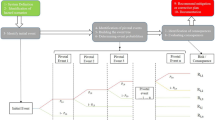Abstract
This paper presents a systematic investigation about the extremely low-frequency magnetic fields generated in the vicinity of high voltage overhead power transmission lines constituting the Algerian national electricity power transmission grid. The influences of loading current on the magnetic field as well as the variation of tower configuration and conductor section are investigated. Simulations are made by COMSOL software and experimental measurements of magnetic field near overhead power transmission lines are performed by Chauvin Arnoux C.A 40 gaussmeter. Both Simulation results and measurements are compared to safety exposure limits given by International Commission on Non-Ionizing Radiation Protection ICNIRP. Well agreements are found between simulations and experiments overall the three considered voltage levels 60/220/400 kV and for all shapes of lines and towers.
















Similar content being viewed by others
References
World Health Organization (WHO) (2007) Extremely low frequency fields. Environmental health criteria, vol 238. World Health Organization, Geneva
Establishing a dialogue on risks from electromagnetic fields, radiation and environmental health department of protection of the human and environment, WHO Geneva, Switzerland 2002
French Agency for Food, Environmental and Occupational Health & Safety (ANSES) report n°«2013-SA-0037» August 2015 (in French). International Agency for Research on Cancer IARC. Non-ionizing radiation Part 1: ″Static and extremely low-frequency (ELF) electric and magnetic fields″
World Health Organization 2002
CIGRE Technical Brochure 616 ″Externalities of Overhead High Voltage Power Lines″ Working Group C3.08, April 2015 (CIGRE report)
Vergara XP, Kavet R, Crespi CM, Hooper C, Silva JM, Kheifets L (2015) Estimating magnetic fields of homes near transmission lines in the California Power Line Study. Department of Health & Human Service HHS, CA
Marincu A, Greconici L, Muşuroi L (2005) The electromagnetic field around a high voltage 400 kV electrical overhead lines and the influence on the biological systems. Politehnica University of Timisoara, Romania
Ida N (2015) Engineering electromagnetics, 3rd edn. Springer, University of Akron, OH
Louie H (2018) Off-grid electrical systems in developing countries . Springer, Seattle
Kheifets L, Crespi CM, Hooper C, Oksuzyan S, Cockburn M, Ly T, Mezei G (2015) Epidemiologic study of residential proximity to transmission lines and childhood cancer in California: description of design, epidemiologic methods and study population
ICNIRP Safety Guideline (2010) Guidelines for limiting exposure to time-varying electric and magnetic fields (1 Hz–100 KHz). Health Phys Soc 99(6):66
Technical report of Algerian Electricity Company GRTE, 2019
Plan as built overhead power transmission lines, Algerian Electricity Transmission Company GRTE, specific technical documents
The ten–year network development plan for Algerian national grid 2019–2029 by GRTE 2018
Conductor AAAC, Standard: NFEN 50182
El Dein AZ (2009) Magnetic field calculation under EHV transmission lines for more realistic cases. IEEE Trans Power Deliver 24(4):2214–2222
F. POLLACZEK, About the magnetic field produced by an infinitely long single conductor traversed by an alternating current, Revue Générale d’Électricité 1931 (in French)
Olsen ABG, Backus ABG, Stearns RD (1995) Development and validation of software for predicting ELF magnetic fields near power lines. IEEE Trans Power Deliv 10(3):66
Bürgi A, Sagar S, Struchen B, Joss S, Röösli M (2017) Exposure modelling of extremely low-frequency magnetic fields from overhead power lines and its validation by measurements. Int J Environ Res Public Health 5:66
Salam GA (2013) Measurements of magnetic fields in the indoor power distribution transformers and in the vicinity of the HV overhead power lines in Egypt. In: 22nd International conference on electricity distribution, Stockholm, 10–13 June 2013
Guide for Low Frequency Magnetic Field Measurements, C.A 40 Gaussmeter, CHAUVIN ARNOUX
Guide for Suparul Cable Height Meter, Modeles 190, 300, 300DT, 300E, 600, 600E, DT80
Acknowledgements
We thank Professor Mostefa Brahami for making available to us the magnetic measurer equipment. Also, Professor Hocine Moulai is thankfully acknowledged for his comments on an earlier version of the manuscript, although any errors are our own and should not tarnish the reputations of these esteemed persons. At last, we thank GRTE, Algerian National Power Transmission Company for their valuable input in producing this article.
Author information
Authors and Affiliations
Corresponding author
Additional information
Publisher's Note
Springer Nature remains neutral with regard to jurisdictional claims in published maps and institutional affiliations.
Rights and permissions
About this article
Cite this article
Belkhiri, Y., Yousfi, N. Assessment of magnetic field induced by overhead power transmission lines in Algerian National Grid. Electr Eng 104, 969–978 (2022). https://doi.org/10.1007/s00202-021-01298-2
Received:
Accepted:
Published:
Issue Date:
DOI: https://doi.org/10.1007/s00202-021-01298-2




